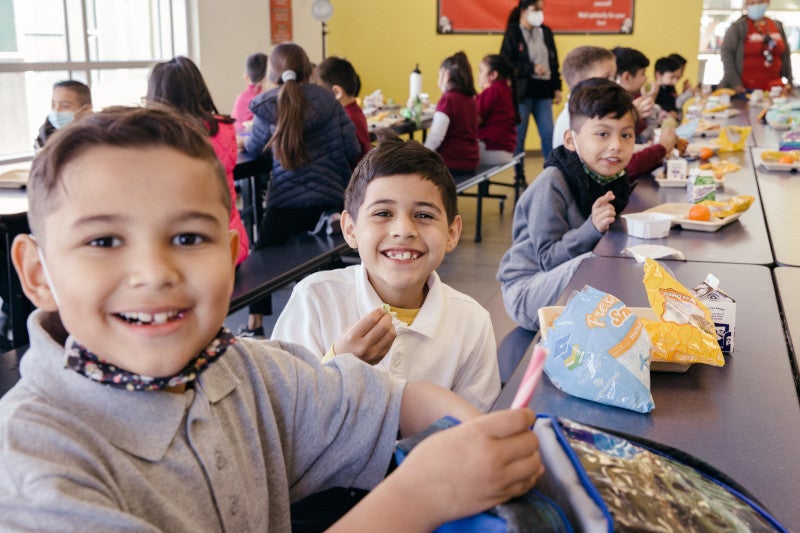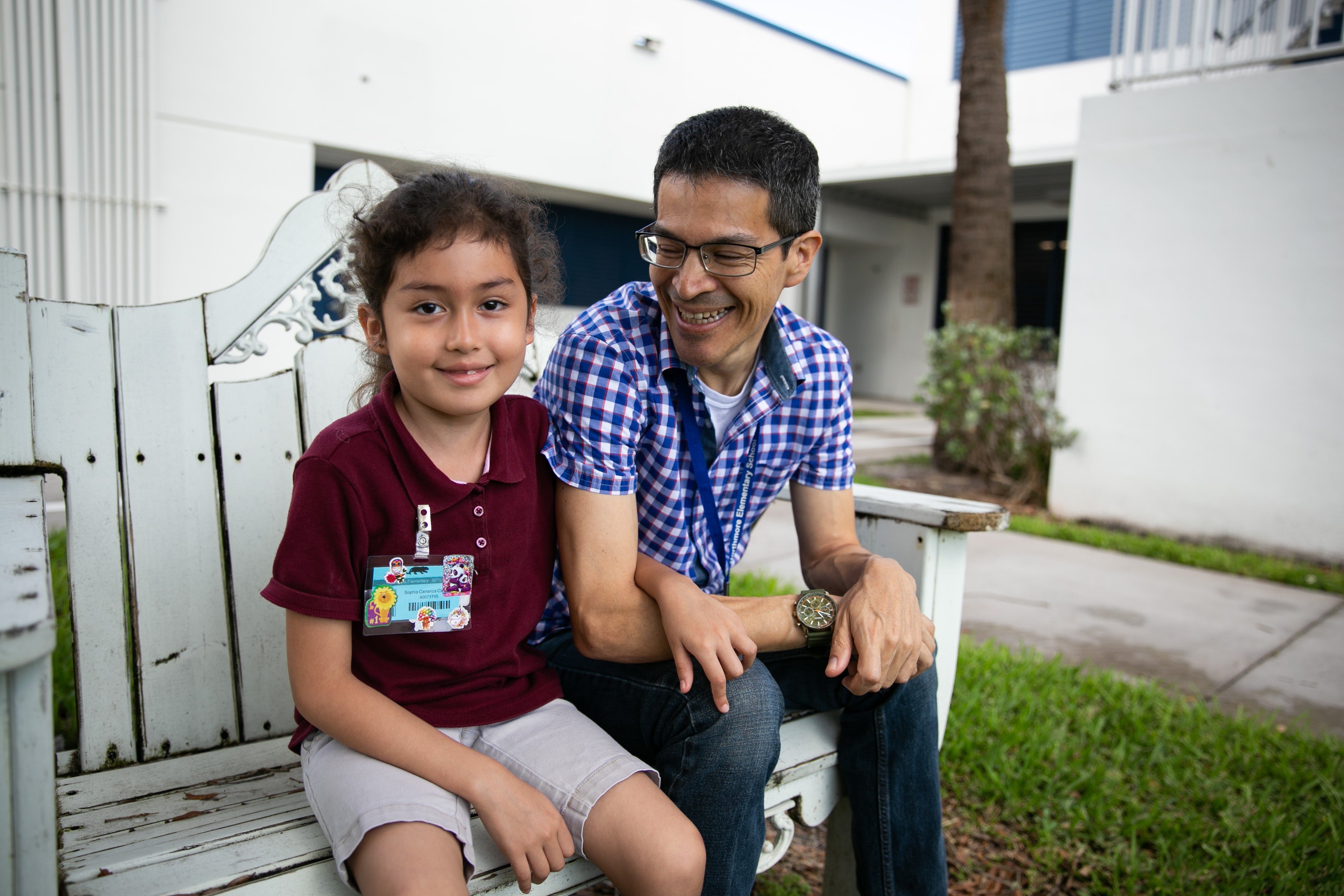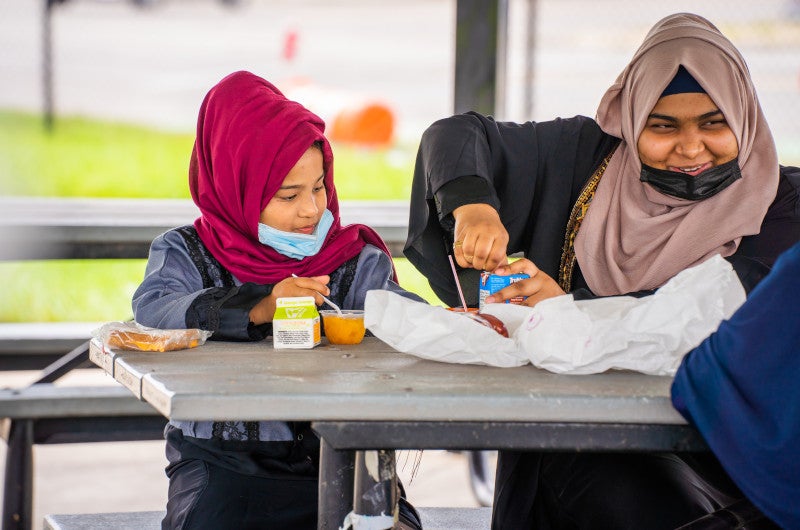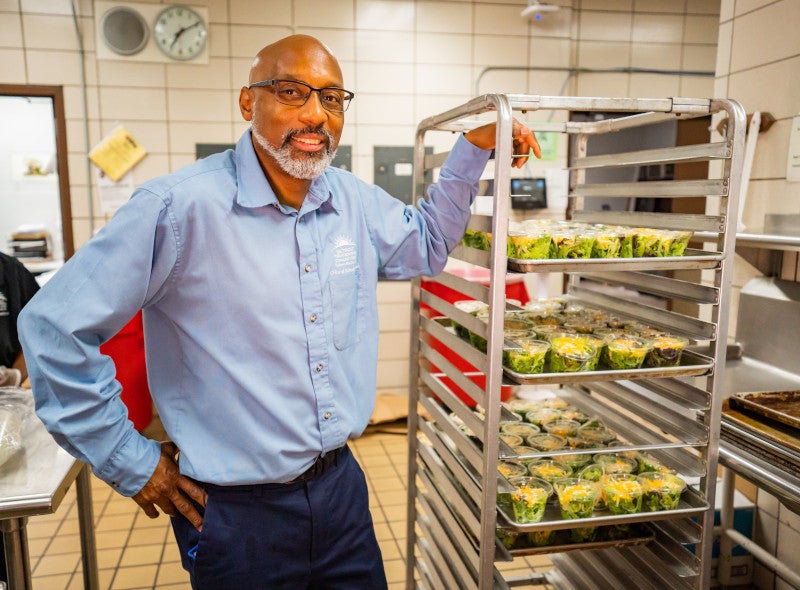Millions of children across the U.S. are living with hunger. The educators we work with, like Staci Okuno, seventh grade science teacher at Rialto Middle School in California, know firsthand how hunger affects kids.
“You can hear stomachs growling in the classroom,” said Okuno. “Sometimes they’re just so tired because they haven’t had anything to eat that they’ll just put their heads down and go to sleep.”
No child should go hungry in America. That’s why No Kid Hungry — with the support of our donors — is ensuring kids get three meals a day to grow up healthy, happy and strong.
A major way we do this is by supporting and investing in school meals programs, which play an essential role in feeding kids. Federal child nutrition programs, which allow students to receive breakfast, lunch or after school meals for free or pay a reduced price based on their family’s income, reach millions of children across the country.
“I have always loved my school meals because they’ll always help me be successful in life… just remember, always eat your meals and you’ll always be successful when you do.”
— Serenity, 3rd Grade, Palm Beach County, FL

No Kid Hungry funds schools directly through grants that help them get the critical resources they need, including basic supplies and new equipment such as trucks, refrigerators, cooler bags and carts for delivering meals, as well as tools to implement innovative delivery models. We also conduct research and provide guidance and advocate for laws that make school meals available to more children.
In addition to lifting some of the financial burden from families, school meals give children access to healthy food that powers their day, sets them up for success in the classroom and ultimately helps them thrive.
The Impact of School Meals
In many ways, school meals are just as important as a child’s textbook. Kids can’t learn on an empty stomach, and school meals help kids focus on the important stuff instead of worrying about hunger. When kids feel better, they do better.
There are a variety of ways that schools feed kids, but some of the primary meals fueling kids across America during the school week are breakfast, lunch and after school meals.
“Nine times out of ten, we give them a snack, and it helps. Breakfast is important for kids; feeding the brain helps them concentrate. You know, [their] belly’s full, they’re comfortable, they’re in a good mood.”
— Frances Montoya-Gatewood, Vaughn Next Century Learning Center, San Fernando Valley, CA
School Breakfast

No Kid Hungry remains committed to ensuring every child starts the day with a nutritious school breakfast — a powerful and critical tool that helps kids begin the school day ready to learn. When kids kick-start their day with a healthy school breakfast, research shows that students:
- boost their academic performance, grades and test scores
- increase their concentration, alertness, comprehension and memory
- improve their classroom behavior
- reduce their absenteeism and tardiness
School breakfast provides the consistent nutrition kids need to learn, grow and reach their full potential, but millions of kids aren’t getting the healthy breakfast they need to start their day.
“The program has affected grades by allowing kids to be more alert...it’s made them more ready to start their day. They have their nutrients, they have eaten their breakfast, they have talked with their friends and now their morning has become more calm and ready to get their day started.”
— Lauren Casey, teacher, New Orleans
Making Breakfast Part of the School Day
At No Kid Hungry, we’ve learned that helping schools adopt breakfast programs is one of the best ways to feed more kids. We fund and support different kinds of breakfast programs to meet the varying needs of schools. Popular models include:
- Breakfast In the Classroom: Once the school day begins, students can eat breakfast in their classrooms. Students or staff deliver breakfasts packed in coolers or insulated rolling bags from the cafeteria.
- Grab And Go: Students can pick up conveniently packaged breakfasts from mobile service carts in high traffic areas, such as hallways, entryways or cafeterias. Students can eat in their classrooms or in a common area before and after the bell.
- Second Chance Breakfast: Students eat breakfast during a break in the morning, often between first and second period or midway between breakfast and lunch. Schools can serve breakfast using a grab-and-go model, or they can open the cafeteria to serve breakfast during the break. Second chance breakfast is especially effective for middle or high school students who may not be hungry first thing in the morning or prefer to socialize with friends.
Number of kids across the country who received a free or reduced-price breakfast on an average day before the pandemic.
School Lunch
For the millions of children who receive a free or reduced-price school lunch, these nutritious, convenient and affordable meals fill in the gaps that many kids are missing at home by increasing their health and overall well-being.
- Better nutrition increases students’ concentration and improves their cognitive function, which leads to higher test scores and a better education.
- School lunches are designed to meet specific nutritional needs for growing kids. When these standards are met, kids are less likely to get sick or miss school.
- Children who are nourished are less irritable, get along better with classmates and cause fewer classroom disruptions.

“Ayudan mucho y han sido una bendición, porque los recursos son bastantes limitados hoy en día por la inflación. Tener que tener dos trabajos, aún así el dinero es estrictamente necesario para vivir dignamente, digamos. El hecho de que le colaboren a uno en la escuela para el desayuno y el almuerzo de la niña es una gran ayuda para la familia.”
Translation: “[The meals] help a lot and they have been a blessing because resources are very limited today with inflation. I work two jobs and even like this, there is only money for what’s strictly needed to live with dignity. The fact that [the school] helps with breakfast and lunch of my girl is a huge help for my family.”
— José Carranza, Father of Sophia Carranza, Palm Beach County, FL
The National School Lunch Program is one of the oldest and largest child nutrition programs with the highest participation rate. Because of its positive effects on students’ health, learning and well-being, it’s a school meals program that No Kid Hungry wants to see continue.
During the pandemic we saw schools come up with a variety of new ways to feed kids lunch. We provided funding and support for those efforts, and today we continue to help schools improve their lunch programs.
Number of kids across the country who received free or reduced-price school lunch on an average day before the pandemic.

“I’m really proud of the staff that they’re giving meals and especially for halal food. It’s really helpful for Muslim people because they can’t eat the non-halal food. And also, because the school’s offering so many meals for the students. During the pandemic, [it] was very helpful, because as we know that healthy food, especially in Detroit, is very expensive."
— Fatima Rahman, high school senior, Detroit, MI
Afterschool Meals
Not every child gets the healthy food they need at home at night. For those kids, after-school meals are vital.
No Kid Hungry helps schools and community organizations launch and improve afterschool meals programs, from funding staff and equipment to helping local leaders learn how the program works. (Afterschool meals programs are governed by different rules than breakfast and lunch, and sometimes; school staff need help navigating the complexities.)
Parents who can’t afford to feed their children before they go to bed consider afterschool meals a lifesaver. The program is also especially invaluable to kids whose parents work long or nontraditional hours, commute long distances, or need childcare when the school day ends.
Afterschool meals not only combat hunger and give kids the healthy fuel they need to learn, grow, and play after school, they also give kids a better chance to learn during the school day. Studies show that when kids eat meals during out-of-school time, they help with test scores, attendance and graduation rates.

“I’ve been in students’ homes and I’ve seen the lack of food. And seeing that really motivates you to really do a good job here, but we won’t be able to solve hunger just by throwing food at it, right? There’s so many other aspects to solving this problem. But while we work on solving the problem of hunger and poverty, making sure every child has something to eat… worrying about where I’m going to eat and what I’m going to eat should not be a worry of a child.”
— Carl Williams, FNS Director Detroit Public Schools Community District
What You Can Do to Help Feed Kids
No Kid Hungry supports the many dedicated program and food service staff, school nutrition professionals and other essential individuals who are working on the frontlines to effectively deliver school meals to children. This includes providing grants, promoting advocacy and supplying other vital resources. In addition to delivering best practices, new skills and peer-to-peer learning to schools across the country through national webinars and toolkits, No Kid Hungry is also joining the White House Conference on Food and Nutrition to advocate for policies that improve nutrition access for families.
When you support No Kid Hungry, here is some of the magic you can make happen.
- Transform a used food truck into a mobile meals unit to bring meals to kids.
- Deliver school meals to children in classrooms with rolling carts and new coolers that help keep meals cold and safe.
- Increase the number of staff necessary to operate sustainable, effective meal programs.



